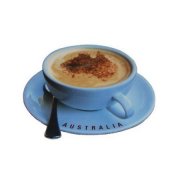How is the planting of single bean at Hartman Manor in Panama? Hartman Manor single bean won the prize.

Professional barista communication, please pay attention to coffee workshop (Weixin Official Accounts cafe_style)
Hartmann Manor is currently handled by Hartmann Troetsch's five children, among which Ratibor and Kelly are mainly responsible for planting, breeding and fertilization in the park, which are important to coffee quality. They are the soul of Hartmann Manor. In addition to their own estate, the Hartmann family also provides management services for estates near Volcan, such as Ninety Plus's estate in Panama, which has maintained close cooperation with the Hartmann family to manage various matters within the estate.
The Eye of Water has always been a favorite area of Hartmann Manor. This area is located at a higher elevation in the Manor. The annual production is very rare. Only a few species of geisha, kadura and kaduyi are cultivated in this area. The total area of the Manor is 120 hectares, of which only 20 hectares are planted. Another estate named Santa Clara, in addition to serving as a coffee estate and nursery garden, is also the location of Hartman Estate's washing plant, and this area is also the place where the estate mainly experiments on the flavor performance of different varieties. At present, more than ten varieties are being tested, and more varieties with potential are planned to be planted in the future.
Hartmann Estate washed
Country: Panama
■ Production area: Walken
■ Altitude: 1250-1800 m
■ Treatment method: washing
■ Level: SHB
■ Breed: Arabica
■ Flavor description: stone fruit, cream, vanilla and herbaceous endings
Hartmann Estate Natural
Country: Panama
■ Production area: Walken
■ Altitude: 1250-1800 m
■ Treatment method: sun exposure
■ Level: SHB
■ Breed: Arabica
■ Flavor description: aroma, juice, grape, longan
Hartmann Pacamara Sunlight Hartmann Estate Pacamara Natural
Country: Panama
■ Production area: Walken
■ Altitude: 1250-1800 m
■ Treatment method: sun exposure
■ Level: SHB
■ Breed: Pakamara
■ Flavor description: dried fruit, smoke, cardamom spices, onion, melon and fruit aroma
Hartmann Geisha Sunlight Hartmann Estate Geisha Sunlight Hartmann Estate Geisha Natural
Country: Panama
■ Production area: Walken
■ Altitude: 1250-1800 m
■ Treatment method: sun exposure
■ Level: SHB
■ Breed: Geisha
■ Flavor description: citrus, melons, tropical fruits
Hartmann Estate is a coffee estate owned by the Hartmann family.
The estate was founded by Alois Strasil Hartmann.
He came to Panama's Boquete district around 1918 to start his farming career.
Hartmann Estate currently owns two coffee farms, Ojo de Agua and Palo Verde.
About two miles apart. Ojo de Agua coffee is grown under shade trees
There are many areas in the estate that are virgin forests
It's also a famous place across Costa Rica and Panama
One of the buffer zones of La Amistad Forest Reserve,
Average elevations fall between 1220 and 1828 meters,
Mud roads within the estate lead to the native habitats of various plants and animals.
Ideal for birdwatching, hiking and exploration.
Palo Verde Farm is known as Hartmann Manor.
Coffee grown here also grows under rainforest shade trees.
Average altitude of 1250 meters, average annual temperature between 12.7 and 26.6 degrees,
Annual rainfall of 4500 cm,
There are dirt roads extending in all directions
There is also a small museum that houses insect specimens and local artifacts.
Panama Panama
Population: 3406000
Coffee in Panama is defined by how it is produced, not by geography. In the past, when coffee was widely cultivated, when the areas listed below were small and densely clustered, the beans produced could be combined into a unit.
BOQUETE
The Bok region is the most famous Panamanian region. Its mountainous terrain creates many microclimates. Cooler weather and frequent fog help slow coffee cherry ripening, and some people think this is akin to high-altitude climate.
Altitude: 400- 1,900 m
Harvest: December-March
Breeds: Typica, Caturra, Catuai, Bourbon, Geisha, San Ramon
VOLCAN-CANDELA
Candela Volcano This area produces most of Panama's food and some amazing coffee. The region is named after Baru volcano and the city of Piedra Candela, and borders Costa Rica.
Altitude: 1,200- 1,600 m Harvest: December-March
Breeds: Typica, Caturra, Catuai, Bourbon, Geisha, San Ramon
RENACIMIENTO
Renacimiento is a region in the province of Chiriqui, bordering Costa Rica. The area itself is relatively small, so it is not Panama's main specialty coffee producing area.
Altitude: 1,100- 1,500 m
Harvest: December-March
Breeds: Typica, Caturra, Catuai, Bourbon, Geisha, San Ramon
Panama Hartmann Estate
When it comes to Panama's coffee tradition, most of the more familiar fine coffee regions come from Boquete, but in recent years, Volcan coffee has gradually emerged on the fine market, and quite a few estates have entered the Best Panama competition.(Best of Panama) Even won the championship, the region generally has less annual rainfall than the Borquette, and the geographical environment west of Baru volcano also makes coffee and Borquette regions have stronger dry fruit flavor, sweetness and aroma. In the early days of Volcán, most of the cash crops such as fruits and vegetables were cultivated in this area, and only a relatively small number of farmers cultivated coffee. Among the pioneers of coffee cultivation in Volcán, the Hartmann family was quite famous in Panama.
The story of Hartmann family in Panama can be said to be a very long history of European immigration. Alois Strasil Hartmann was born in the Austro-Hungarian Empire at that time, that is, the Czech Republic today. Later, due to the unstable political situation of the country, he decided to start a new life in other places. At first, Alois stayed in new york and then moved to Panama. However, after staying for a few months, Alois found that he did not adapt to the urban life of Panama City. There was always adventurous DNA hidden in his blood. He married his first wife Susana Troetsch and gave birth to Hartmann Troetsch, the founder of Hartmann Manor. Hartmann Troetsch inherited his father's farmland from 1940 and began to work on the land. Hartmann decided to keep most of the original forest land in the estate until today. The concept of native forest protection has also influenced the third generation of manor owners responsible for management. Hartman Manor still maintains this tradition. The coffee planting area in the manor only accounts for about 20% of the whole manor. Due to the achievements of forest protection, there are quite a few native birds in the manor. The most famous lark in the local area has naturally become the standard Logo of the manor.
Important Notice :
前街咖啡 FrontStreet Coffee has moved to new addredd:
FrontStreet Coffee Address: 315,Donghua East Road,GuangZhou
Tel:020 38364473
- Prev

What are the suggestions for baking single beans in Hartman Manor in Panama?
Professional barista communication please follow the coffee workshop (Wechat official account cafe_style) Hartman Manor washing Hartmann Estate Washed ■ country: Panama ■ area: Walken ■ altitude: 1250-1800 m ■ treatment: washed ■ Grade: SHB ■ Variety: Arabica ■ Flavor description: drupe, cream, vanilla and herb finish
- Next

How to deal with the processing of Hartman Manor beans in Panama? what is the grade of Hartman Manor beans?
Professional barista exchanges please follow the coffee workshop (Wechat official account cafe_style) the story of the Hartman family in Panama can be said to be a long history of European immigration. Alois Strasil Hartmann was born in the Austro-Hungarian Empire at that time, that is, the present-day Czech Republic, and then decided to start a new life outside the country due to the unstable political situation of the country. At the beginning, Aloi
Related
- Does Rose Summer choose Blue, Green or Red? Detailed explanation of Rose Summer Coffee plots and Classification in Panamanian Jade Manor
- What is the difference between the origin, producing area, processing plant, cooperative and manor of coffee beans?
- How fine does the espresso powder fit? how to grind the espresso?
- Sca coffee roasting degree color card coffee roasting degree 8 roasting color values what do you mean?
- The practice of lattes: how to make lattes at home
- Introduction to Indonesian Fine Coffee beans-- Java Coffee producing area of Indonesian Arabica Coffee
- How much will the flavor of light and medium roasted rose summer be expressed? What baking level is rose summer suitable for?
- Introduction to the characteristics of washing, sun-drying or wet-planing coffee commonly used in Mantenin, Indonesia
- Price characteristics of Arabica Coffee Bean Starbucks introduction to Manning Coffee Bean Taste producing area Variety Manor
- What is the authentic Yega flavor? What are the flavor characteristics of the really excellent Yejasuffi coffee beans?

